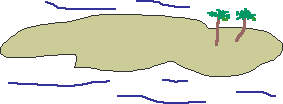

Introduction
This activity will introduce you to the decisions that go into designing well performing houses, or in other words, houses that provide comfortable and productive spaces.
Your job in the Stranded! activity is to work with a group of students to design a reasonably comfortable shelter for a scenario in which you are stranded on an island and only have a few given building material supplies and a few more options from which you can select.
You will be given choices of what materials you want to use to design your shelter. After you have made your choices and designed your shelter, you will compare your choices and design to ones that experts have made to see how your shelter will do in providing adequate and comfortable quarters.
Directions
Your teacher will put you in teams of 3-4 students. Your team will first need to choose three supplies from a list of six to use in combination with what you find on the island to build your shelter. Then decide how you want to build the shelter from the supplies you’ve chosen. You will have to justify (explain) your choices. Finally, make a drawing of the shelter along with a one or two paragraph description.
The Scenario
You have
just swum up on shore after you ran your boat into a reef. Bummer. You’re
confident you’ll eventually be rescued, but you also realize that
you may have to survive on your own for a month or so before that happens.
You need come up with some kind of a shelter!
| This is what your island looks like. A quick survey tells you that it’s only about the size of a football field and fairly flat with only a few palm trees. The good news, though, is that there are a lot of coconuts and even some oranges that have washed up on shore - so you’re o.k. on food. |  |
You’ve been boating in the area long enough to also know a few things about the area. There should be no real problems with animals or biting bugs, but it gets close to 90oF almost every afternoon and there is a lot of sunshine, making staying outside for long periods during the day impossible. On the plus side, you also know that nighttime temperatures are usually between 70 and 75oF. Generally winds are light except they can get very strong during afternoon rainstorms that occur 2-3 times per week. Along with the coconuts, you’ve found a few items that have washed up on the island that should be helpful. These include: |
|
- (6) 4' x 4' pallets (pallets are slats of wood fastened together, typically used in shipping -- assume the pallets will block rain and the sun well enough to be used as walls but not as a roof)
- (1) 4' x 8' sheet of exterior plywood
- (1) Knife (rusty, but usable)
- A few small pieces of driftwood
The Swim
While thinking about the items you have just found, you look up to see your boat slowly sinking. It’s a hike (well, a swim) out to it, but you’re a good swimmer so there’s just enough time to grab any three of the options below from the boat before it goes down. Work with your team members to decide which three items to select:
- 4' x 8' plastic tarp
- Bubble wrap (4' x 20' roll)
- Aluminum foil (16" x 25' roll)
- 100' rope
- Staple gun
- Video game (battery powered)
The Challenge
Once you’ve
decided on three items, as a team, decide how to build the shelter from
the supplies you’ve chosen. Make a drawing of the shelter along
with a one or two paragraph description to explain what you made and why
you made it the way you did. Remember as you work that you’re trying
to create as “survivable” and comfortable a shelter as you
can- your life may depend on it! After completing the drawing and description,
see the Activity Feedback: Stranded!
section to see how you did.
National Science Standards | Glossary | References | Site Map | Feedback Form
Individual pages from this web site may be printed
and duplicated for
student classroom use
provided that proper credit is given to
the Florida Solar
Energy Center (FSEC).
